
Devonport is a harbourside suburb of Auckland, New Zealand. It is located on the North Shore, at the southern end of the Devonport Peninsula that runs southeast from near Lake Pupuke in Takapuna, forming the northern side of the Waitematā Harbour. East of Devonport lies North Head, the northern promontory guarding the mouth of the harbour.

Queen Street is the major commercial thoroughfare in the Auckland CBD, Auckland, New Zealand's largest city. The northern end is at Queens Wharf on the Auckland waterfront, adjacent to the Britomart Transport Centre and the Downtown Ferry Terminal. The road is close to straight, the southern end being almost three kilometres away in a south-southwesterly direction on the Karangahape Road ridge, close to the residential suburbs in the interior of the Auckland isthmus.
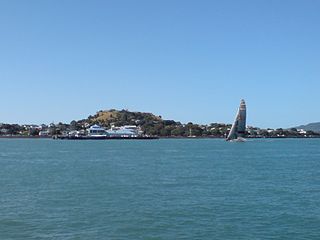
Takarunga / Mount Victoria is the highest volcano on Auckland's North Shore, rising to 66 metres in elevation. Its age is currently unknown. Its lava flows now line much of Devonport's waterfront. Takarunga was the location of an important pā used by Tāmaki Māori peoples. In the late 19th century, a gun fort was built on top of the hill, in order to defend the city of Auckland. As a designated tūpuna maunga, the mountain has been governed by the Tūpuna Maunga Authority, along with thirteen other cones throughout Auckland, since 2014.

Karangahape Road is one of the main streets in the central business district (CBD) of Auckland, New Zealand. The massive expansion of motorways through the nearby inner city area – and subsequent flight of residents and retail into the suburbs from the 1960s onwards – turned it from one of Auckland's premier shopping streets into a marginal area with the reputation of a red-light district. Now considered to be one of the cultural centres of Auckland, since the 1980s–1990s it has been undergoing a slow process of gentrification, and is now known for off-beat cafes and boutique shops.

The Theatre Royal is an Edwardian theatre on Thames Street in Windsor in Berkshire. The present building is the second theatre to stand on this site and opened on 13 December 1910. Built for Sir William Shipley and Captain Reginald Shipley, it was a replacement for their previous theatre which was built in 1815 and had burnt down in 1908. The present theatre was designed by Frank Verity, the son of the theatre architect Thomas Verity. The building is Grade II listed and is the only unsubsidised producing theatre to operate all year round in the United Kingdom.
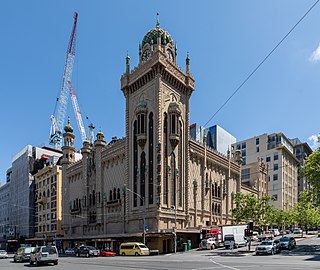
The Forum Theatre is a historic theatre and former cinema now used as a live music and event venue located on the corner of Flinders Street and Russell Street in Melbourne, Australia.

Courtenay Place is the main street of the Courtenay Quarter in the Wellington inner-city district of Te Aro.
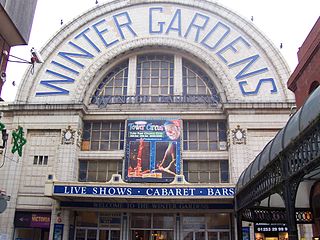
The Winter Gardens is a large entertainment complex in Blackpool, Lancashire, England, which includes a theatre, ballroom and conference facilities. Opened in 1878, it is a Grade II* listed building, operated by Blackpool Entertainment Company Limited on behalf of Blackpool Council, which purchased the property from Leisure Parcs Ltd as part of a £40 million deal in 2010.

The St. James Theatre is a large proscenium stage theatre in central Wellington, New Zealand, and home to the Royal New Zealand Ballet. The building was designed in 1912 by New Zealand-born theatre designer Henry Eli White. It is located on Courtenay Place, the main street of Wellington's entertainment district, opposite the Reading Cinema complex.

The Palais Theatre, formerly known as Palais Pictures, is a historic picture palace located in St Kilda, an inner suburb of Melbourne, Victoria, Australia. With a capacity of nearly 3,000 people, it is the largest seated theatre in Australia.

TheCivic Theatre is a large heritage combination performing-arts theatre, live-music venue, and cinema seating 2,378 people in Auckland, New Zealand. First opened on 20 December 1929, it underwent a major renovation and two-year conservation effort in the late 1990s, and was reopened on 20 December 1999. It is a famous example of the atmospheric theatre style wherein lighting and interior design create the illusion of an open sky complete with twinkling stars, giving the audience the impression of being seated in an outdoor auditorium at night. The Civic is managed by Auckland Live, a business unit of Auckland Unlimited.

An atmospheric theatre is a type of movie palace design which was popular in the late 1920s. Atmospheric theatres were designed and decorated to evoke the feeling of a particular time and place for patrons, through the use of projectors, architectural elements and ornamentation that evoked a sense of being outdoors. This was intended to make the patron a more active participant in the setting.
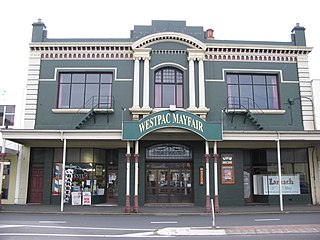
The Mayfair Theatre, Dunedin, New Zealand, was opened on 8 December 1914 as the "King Edward Picture Theatre". It is owned by the Mayfair Theatre Charitable Trust and serves as a 400-seat venue for live performances for a number of local community groups and as the Dunedin venue for some touring agencies.

The St James Theatre is a historic stage theatre and cinema located on Queen Street in Auckland, New Zealand. Built in 1928 to a design by Henry Eli White, it replaced the older Fuller's Opera House and was originally designed for vaudeville acts. It shortly started showing films and up until the early 2000s was used for both live performances and film. St James Theatre was damaged following a blaze at the building in 2007. Since 2017 it has been closed. Restoration work was scheduled to begin in 2024.

The Civic was a building in Manchester Street, central Christchurch, that was erected in 1900 and demolished in 2011. It was first used as an exhibition hall, then as a cinema, and then a theatre, before being gutted by fire in 1917. The northern part of the building was purchased by Christchurch City Council (CCC) and opened as the civic office in 1924, and served this purpose until 1980. After that it had several uses, including a restaurant, bar and live music venue. The building was heavily damaged in the February 2011 Christchurch earthquake, and was demolished.

The Odeon Theatre in Christchurch was the oldest masonry theatre in New Zealand, and one of only three remaining purpose-built 19th-century theatres in the country. The building has had different names over the years, and was put to many different uses. It was damaged beyond repair in the 22 February 2011 Christchurch earthquake and partially demolished in September 2012. The theatre was recognised as a Category I heritage building by the New Zealand Historic Places Trust, with registration number 3140. One of its most notable aspects was its use as a public meeting venue of Kate Sheppard during her women's suffrage campaign.
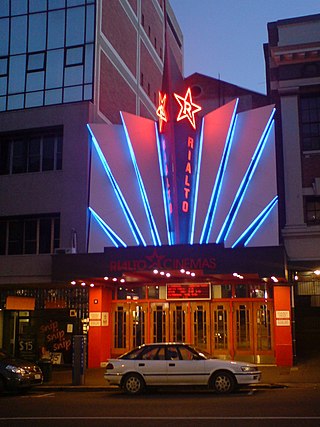
The Rialto Cinema is a multiplex cinema located in the New Zealand city of Dunedin. It was opened in 1998.

Henry Eli White, also known as Harry White, was a New Zealand-born architect best known for the many theatres and cinemas he designed in New Zealand and Australia in the 1910s and 1920s. Many of the major surviving historic venues in the two countries are White designs, including the St. James Theatre, Wellington, St. James Theatre, Auckland, the Capitol Theatre and State Theatre in Sydney, and the Palais Theatre and the interiors of the Princess Theatre and Athenaeum Theatre in Melbourne. He also designed the City Hall and the attached Civic Theatre in Newcastle, New South Wales.
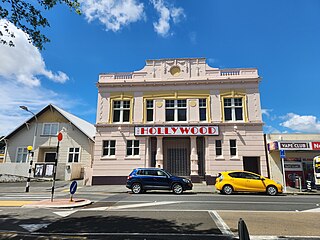
The Hollywood Cinema, also known as the Hollywood or the Hollywood Avondale, is a cinema and performing arts theatre in the suburb of Avondale, Auckland, New Zealand. Under different names and management, the business and the building evolved from the council-administrated Avondale Public Hall built in 1867. Following a name change and installation of a new frontage in 1915, the Hall was leased to Harry Empson, who showed movies in the venue from 1916 to August 1927 when he sold the business to Frederick William.

New Zealand performing arts venues are places in New Zealand that are set up to host performing arts and music events such as theatre, dance and concerts.





















